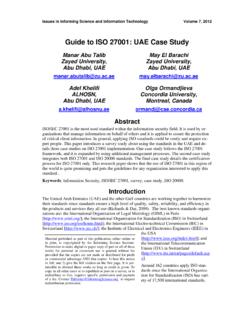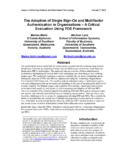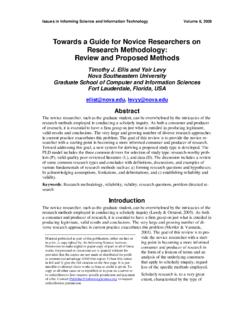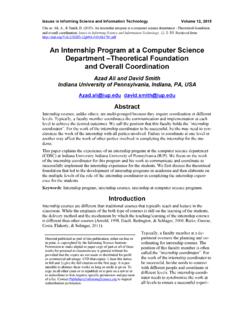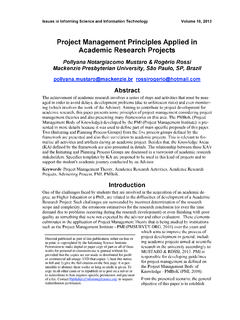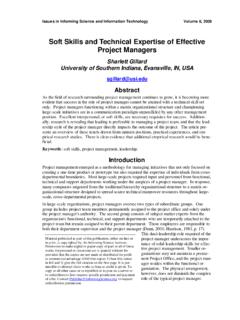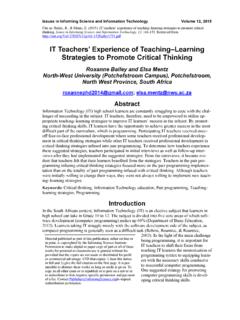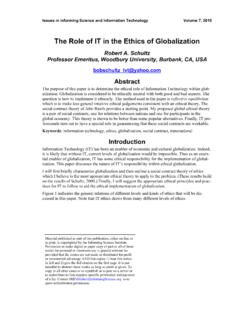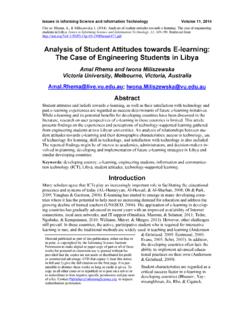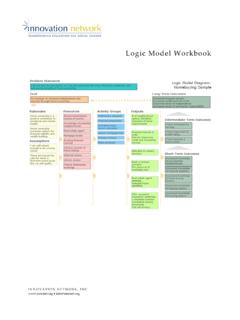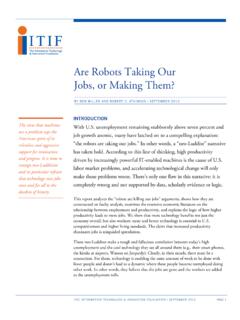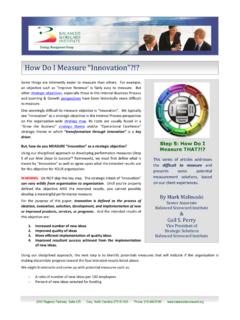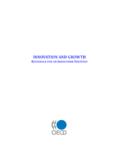Transcription of Making a Case for Change Management Theory to …
1 Issues in Informing Science and Information Technology Volume 8, 2011. Making a case for Change Management Theory to support IS/IT Curriculum innovation Susan Benvenuti University of the Witwatersrand, Johannesburg, South Africa Abstract The complex and dynamic nature of the IS discipline and field poses an ongoing challenge for IS. educators in terms of both what and how they teach. Responses to the curriculum challenge are many and varied, resulting in a diversity of approaches through which IS academics and educa- tors attempt to manage the tension between current industry demands and good academic prac- tice, while taking cognizance of the future developmental needs of IS graduates during their ca- reers.
2 Many of the curriculum innovations or pedagogical choices require significant changes to the teaching and learning environment for both student and teacher, resulting in programs or courses that, despite careful planning, sound pedagogical decisions and good intentions, do not fully deliver the desired or expected results. This work-in-progress paper explores the idea of adapting business Change Management and organizational development principles and frame- works to guide the curriculum design and implementation process. An undergraduate self- directed learning experience provides the context for reflection and an experimental thinking ground.
3 Keywords: IS education, curriculum design and implementation, pedagogical Change , Change leadership, Change Management , organizational development, self-directed lifelong learning Introduction IS Educators are faced with the ongoing challenge of how to prepare future IS professionals for the complex and dynamic world in which they will work. With accelerating technological inno- vation, a growing number of new and diverse roles and career paths, and the need to manage the demands of the industry for ready knowledge and skills, IS educators draw on an increasingly broad set of pedagogical and assessment principles in order to meet these educational challenges.
4 In common with a growing number of disciples including medicine, engineering, law and educa- tion, IS educators are focusing on the development of IS graduates as self-directed lifelong learn- ers during their formal education, in order that they may be able to successfully meet ongoing professional development needs throughout their careers. Material published as part of this publication, either on-line or in print, is copyrighted by the Informing Science Institute. In response to the need to expose stu- Permission to make digital or paper copy of part or all of these dents to self-directed learning in order to works for personal or classroom use is granted without fee start developing the skills, attitudes and provided that the copies are not made or distributed for profit abilities needed for successful lifelong or commercial advantage AND that copies 1) bear this notice in full and 2) give the full citation on the first page.
5 It is per- learning, I devised a self-directed learn- missible to abstract these works so long as credit is given. To ing component as part of a 2nd year sys- copy in all other cases or to republish or to post on a server or tems development course. The reaction to redistribute to lists requires specific permission and payment by some students to aspects of what I. of a fee. Contact to request redistribution permission. was trying to facilitate was unexpected, Change Management Theory leaving me wondering how to best achieve some level of exposure to self-directed learning while dealing with their fear, resistance and in some cases apathy.
6 While reflecting on the reactions and behaviors of the students in response to the self-directed learning component, I was struck by the fact that this intervention was changing some fundamen- tal aspects of the way students were used to working, as well as challenging the expectations tra- ditionally linked to the role of student and lecturer. I felt therefore, that I was experiencing typi- cal reactions to Change . In this paper I present some work in progress in which I start experi- menting with adapting established business Change Management principles, frameworks and ap- proaches to meet the needs of substantial Change in an educational setting.
7 The purpose of this work is to look to the substantial knowledge of the IS discipline in leading and managing organizational Change together with organizational development to develop some frameworks which can be used in conjunction with pedagogic principles to guide and manage the design and implementation of curriculum innovations in IS/IT education. Background and Approach As the IS discipline continues to grow in scope, so too does the challenge to IS educators. Maier, Clark, and Remington (1998) explored changes in the IS job market over a period of fifteen years and found a growing diversity in IS roles and careers, with IS practitioners often expected to per- form several of these roles during the course of their career, all of which have different require- ments in terms of knowledge and skills.
8 In addition, the work performed in the IS industry is fre- quently of a project type nature requiring IS professionals to constantly adapt to and learn about, new situations and new industries, depending on the requirements of each new project. Curriculum development and review are frequently based on literature related to predicted work- place skill requirements (Noll & Wilkins, 2002), or by working with industry advisors (Sriniva- san, Guan, & Wright, 1999). In IS 2010: Curriculum Guidelines for Undergraduate Degree Pro- grams in Information Systems (Topi et al, 2010) suggest that this major revision in the curriculum guidelines is necessary due to the rapid and frequent Change faced by the ever more global IS.
9 Industry, leading to the need to re-evaluate what the core focus and outcomes of an IS degree should be. Industry demands for students who not only have the required' knowledge but also the relevant skills creates further tension in the debate as to what balance is required between knowledge and skills, and the ongoing debate relating to an academic education versus a fit-for-work training. Kim, Shim and Yoon (1999, as cited in Noll & Wilkins, 2002), report that practitioners and edu- cators perceive the relative importance of key IS issues differently.
10 Achieving a balance between IS fundamentals, and current trends and fads is a major dilemma in IS curriculum design accord- ing to Lightfoot (1999, as cited in Noll & Wilkins, 2002). McMurtrey, Downey, Zeltmann, and Friedman (2008) confirmed previous findings that while IT professionals consider both technical and non-technical skills to be important for entry-level personnel, that the non-technical soft- skills are especially important for all IT positions, particularly for future learning and career ad- vancement. They suggest that universities have a responsibility to ensure that new graduates are prepared from the start of their careers with skills that will allow success in careers in the con- tinually changing IT industry.
